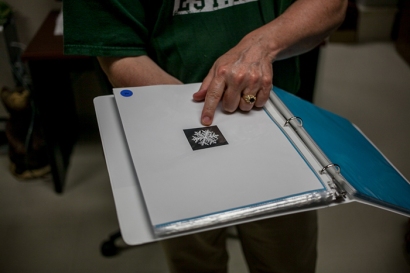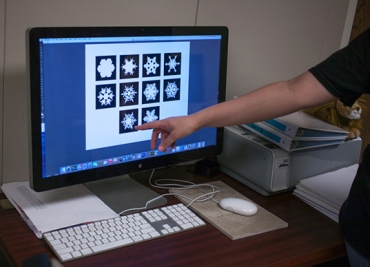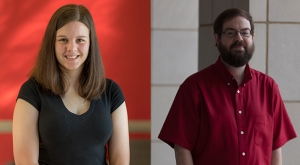Biology
WKU research project uses snowflakes to answer ‘What is Beauty?’
- Wednesday, July 27th, 2016
What is beauty? It’s a question that philosophers, poets, playwrights and the public have debated for centuries.

Images of snowflakes were used in a WKU research project to understand why some visual shapes appear more beautiful than others. (WKU photo by Bryan Lemon)
And it’s a question that Olivia Adkins, a WKU graduate student from Morehead, and Dr. Farley Norman, University Distinguished Professor of Psychological Sciences, have tried to answer in research published online today (July 25) in the journal Perception by SAGE Publishing. More: Read the research report — The Visual Aesthetics of Snowflakes
Instead of looking to artwork or glamour shots for answers, Adkins and Dr. Norman compared unusual subjects – snowflakes and solid objects – to understand why some visual shapes appear more beautiful than others.
“We wanted to know if you can scientifically understand what is beautiful,” Dr. Norman said. “We thought this would be fun to try.”
In two experiments, participants evaluated the perceived beauty of snowflake silhouettes created from photographs of natural snowflakes and the perceived beauty of computer-generated solid objects.
“The relationship between complexity and beauty is stimulus dependent,” Adkins said. “Results were different for snowflakes and the 3-D objects.”
If beauty is in the eye of the beholder, their results showed that participants perceived the complex snowflakes as the most beautiful. The most complex and the simplest solid objects were perceived to be the most beautiful.
“We had a hunch that snowflakes would be a good stimulus set,” Dr. Norman said. “The results are very nice.”
Adkins, who received her bachelor’s degree in psychology from WKU, conducted the research project for her master’s thesis. She will begin her doctoral studies in psychology this fall at Indiana University.

In two experiments, participants evaluated the perceived beauty of snowflake silhouettes created from photographs of natural snowflakes and the perceived beauty of computer-generated solid objects.
In Experiment 1, 204 participants selected the single snowflake and single solid object that was the most beautiful. In Experiment 2, 33 participants rated the perceived complexity and beauty of the entire set of 100 snowflakes and solid objects. When considered as a group, the participants’ results for the solid objects replicated previous findings: the most and least complex objects were perceived as being the most beautiful.
This pattern did not necessarily occur, however, for individual participants. Some participants in Experiment 2, for example, found only complex solid objects to be most beautiful; other participants found only the simple solid objects to be most beautiful. Additional participants perceived both the most and least complex solid objects to be beautiful, while one participant only found moderately complex solid objects to be most beautiful. The results for the snowflakes were more uniform: 91 percent of participants perceived only the complex snowflakes as being most beautiful.
“I was not surprised at all by the snowflakes,” Adkins said.
Contact: Farley Norman, (270) 745-2094
Some of the links on this page may require additional software to view.


